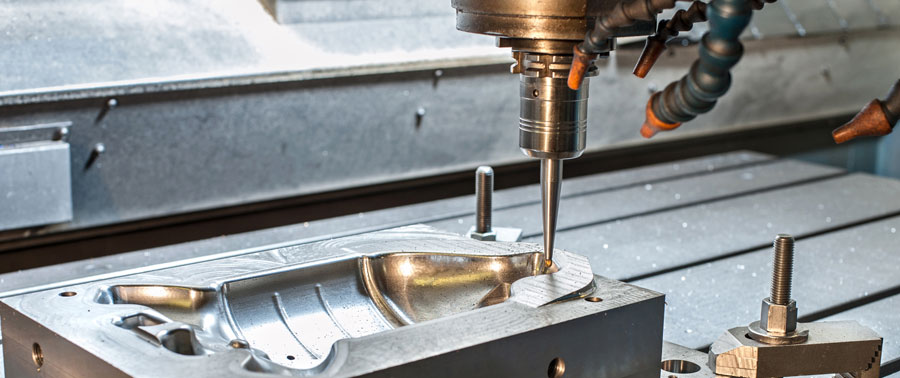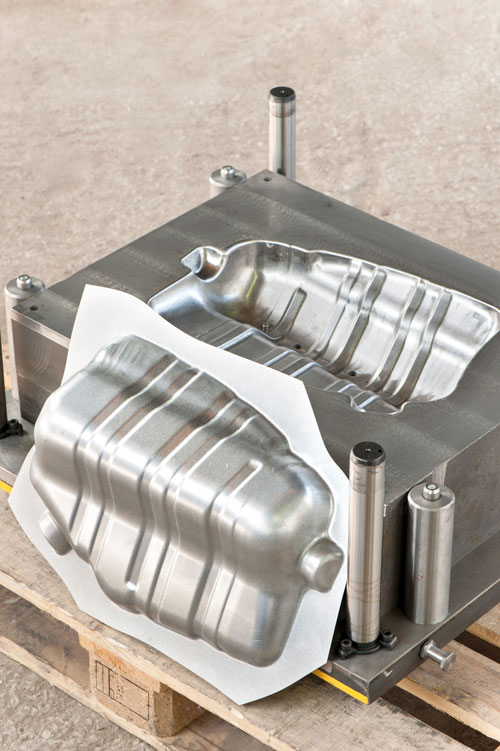2023-10-10 hits:0 source:News
Aluminum die casting alloys are lightweight and possess high dimensional stability for complex part geometries and thin walls. Aluminum withstands good corrosion resistance and mechanical properties as well as high thermal and electrical conductivity, making it a good alloy for die casting. Low-density aluminum metals are essential to the die casting industry. The Aluminum Die Casting process retains a durable strength at very high temperatures, requiring the use of cold chamber machines. The molten metal is still contained in an open holding pot which is placed into a furnace, where it is melted to the necessary temperature. The open holding pot is kept separate from the die casting machine and the molten metal is ladled from the pot for each casting because these high temperatures would damage the normal pumping system. The pressure requirements for cold chamber castings are typically higher than those of hot chamber die castings.

The casting process implements a steel mold often capable of producing tens of thousands of castings in rapid succession. The die must be made in at least two sections to permit removal of castings. The casting cycle begins with the two die halves are clamped tightly together by the die casting press. Molten aluminum is injected into the die cavity where it solidifies quickly. These sections are mounted securely in a machine and are arranged so that one is stationary while the other is moveable. The die halves are drawn apart and the casting is ejected. Die casting dies can be simple or complex, having moveable slides, cores, or other sections depending on the complexity of the casting. Most machines use mechanisms actuated by hydraulic cylinders to achieve locking. Others use direct acting hydraulic pressure. Die casting machines, large or small, very fundamentally only in the method used to inject molten metal into the die.
WHAT ARE THE ADVANTAGES OF ALUMINUM DIE CASTING?
There are many reasons aluminum is the most commonly cast non-ferrous metal in the world. As a lightweight metal, the most popular reason for utilizing aluminum die casting is that it creates very lightweight parts without sacrificing strength. Aluminum die cast parts also have more surface finishing options and can withstand higher operating temperatures than other non-ferrous materials. Aluminum die cast parts are corrosion resistant, highly conductive, have a good stiffness and strength-to-weight ratio. The aluminum die casting process is based on rapid production that allows a high volume of die casting parts to be produced very quickly and more cost-effectively than alternative casting processes. Aluminum die casting has become the favored option for buyers worldwide. Characteristics and Advantages of Aluminum Die Castings include:
Lightweight and Durable
Good Strength-to-Weight Ratio
Great Resistance to Corrosion
Excellent Electrical Conductivity
Fully Recyclable and Reusable in Production
HISTORY OF DIE CASTING MANUFACTURING
die casting moldThe history of Die Casting began in the early 1800’s, with the first die casting equipment being used for the Printing Industry. This technological advancement at the time was beneficial for the purpose of creating a mobile product. During the year of 1849, Sturges earned a patent for the invention of the first small hand manually operated machine designed for casting printing type. These unique Die Castings were designed in order to manufacture a variety of simple to complex shapes while possessing a high level of accuracy, creativity, and a persistent process in order to earn value for the products. In the later years of 1855, Otto Mergenthaler developed the linotype machine that became very popular and efficient piece of equipment used in the publishing industry.

A great demand in the production of commercial die casting grew in the early 19th century due to the growth of the high volume of production in various industries. This movement opened up many different markets for the Die Casting Industry to expand into many diverse operations. During this innovation period, Aluminum and Zinc Die Casting Production took over the initial metals of Tin and Lead due to the higher quality features obtained by these products. The original process of low-pressure injection die casting has changed to the high-pressure casting method as a result of modernized surface finishing and efficient production factors. Throughout history, all major products have been manufactured through die casting processes and have focused on saving companies a great deal of money in production. Consumers can rely on consistent results, durable lifespans, and reliably finished castings for their commercial and industrial needs depending on the demand. Grand View Research has declared that the Die Casting Industry is the largest process segment in the market accounting for 49.7% of global shares in 2016 fiscal year because of low-cost production rates and consistency.
ALUMINUM DIE CASTING PRODUCT SEGMENTATION
The popularity of aluminum has expanded to many applications around the world today, driving competitive market shares primarily for its distinctive features such as lightweight; corrosion resistance, high electrical and thermal conductivity, high stability for complex shapes and high tensile strength. The transportation sector is the largest end-use segment for this industry. The increasing emission laws by the government regulatory authorities, along with consumer demand for a higher fuel-efficient vehicle is developing a necessity for aluminum casting. An example of increased operations for the industry includes the replacement of iron and steel components in a vehicle with lightweight high-quality aluminum in order to increase the fuel efficiency. The Aluminum die cast product is ideal for electronic connectors and housings die to its excellent electrical performance and shielding properties, even in high-temperature environments.
Another sector regarding the aluminum die casting demand includes building and construction in developing economies particularly in the Asia Pacific region. Aluminum Die Casting is associated with the creation of products including windows, cladding, curtain walling, prefabricated buildings, shop partitions, and fittings. Also, aluminum die casting products are used in aerospace operations or airplanes all around the world. The aerospace industry wants to produce a more dense and larger quality product at lower costs for these air-frame components as aircraft continue to grow in size along with population rates.
aluminum casting revenueAccording to Transparency Market Research, the Asia Pacific region accounts for over the half the share in the global market for aluminum castings. In the years ahead, the region is expected to further increase its share by pulling in the maximum Compound Annual Growth Rate of 5.3% during the forecast period between 2017 and 2025, and the powerhouse of China taking most of the credit. This market region is expected to become US $22.67 bn by 2025. Another important driving force includes the regions of Europe and North America in the global market for aluminum castings. While Europe is expected to register a Compound Annual Growth Rate of 5.1% during the forecast period to become worth US $9.45 bn, and the North America regions is expected to rise at a Compound Annual Growth Rate of 4.9% to become worth US $4.22 bn by the end of the year 2025. The statistics provided in this article express the importance in future Aluminum Die Casting growth for global production needs.
ALTERNATIVES TO DIE CASTING – SAND AND INVESTMENT CASTING
Sand and investment casting are methods of creating metal parts by pouring molten metal into three-dimensional molds in the manufacturing industry. The industry is thousands of years old with significant differences existing between these two methods of making metal parts. Sand and Investment Die Casting processes have been refined over the years to minimize the amount of metal used and reduce any extensive machining and finishing required.
Sand Casting is known as the oldest and most widely used casting method in the industry due to its distinct versatile features. The process begins with the molten metal poured directly from a ladle into a sand mold without any high pressure needed. The molds are created by compacting sand around a pattern or model of the final product, and the mold is split apart and the pattern removed. The two halves of the mold are put back together and the void is filled with molten metal. Lastly, the mold is opened when cooled followed by the sand being shaken off the hot casting as the product is then removed for its completion in the process. Many of the same parts can be cast at the same time and share a mold while reusing the same sand multiple times. The mold in a sand casting experiences downtime up to 5 minutes per casting, therefore best applied to parts that are considered lower quantity. The materials used in this process typically lead to less detail or rough surfaces in the final products, which usually requires additional machining operations to smooth out the surfaces. An advantage of sand casting compared to investment die casting is the ease of being able to change mold designs in the sanding process when dealing with changes in the final product.
Investment Casting can also be referred to as precision casting or lost wax casting that manufacturers parts from molten metal, stainless steel alloys, brass, aluminum, and carbon steel. The process starts by creating a wax pattern in the shape of the desired final product. There are three different ways of approaching this step in the process; they include forming a gelatin mold around a solid, creating a metal mold of the final product to fill it with hot wax, or carving a replica of the product out of wax. The wax shape is attached to a tool that is repeatedly dipped into liquid ceramic until the ceramic hardens around the wax shape, forming the shape of the casting. The caster then heats the mold so the wax melts away, leaving a cavity within the ceramic to then be filled with molten metal. Lastly, the metal hardens within the ceramic mold and is then shattered, leaving the cast metal part complete. Investment casting is said to be good for very complex casting designs because of the easier process in creating intricate and precise shapes out of the wax, Investment casting is used if you need zero draft angles on the part, something die casting cannot offer. Investment casting uses the liquid slurry to form the molds, so cast parts can have almost any shape, giving engineers extraordinary freedom in their designs to add intricate features and complex shapes. Investment Casting is more beneficial for lower volume quantities because the part prices are much higher than compared to the traditional die casting method.
Read recommendations:
20mm x 20mm aluminum extrusion
lf you have any questions or comments, you can leave us a message and we will reply to you as soon as possible
